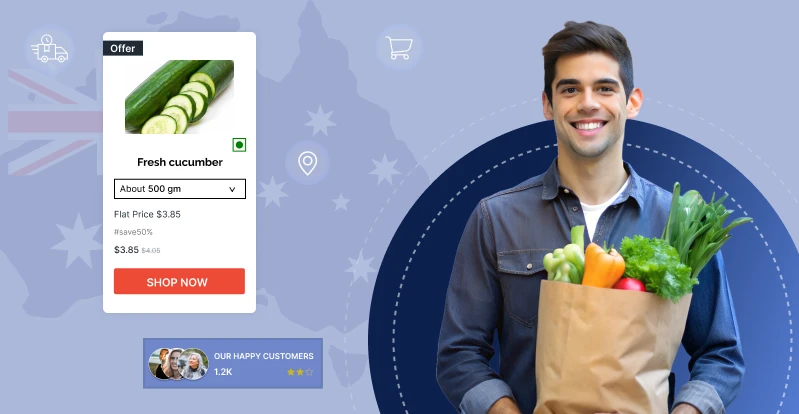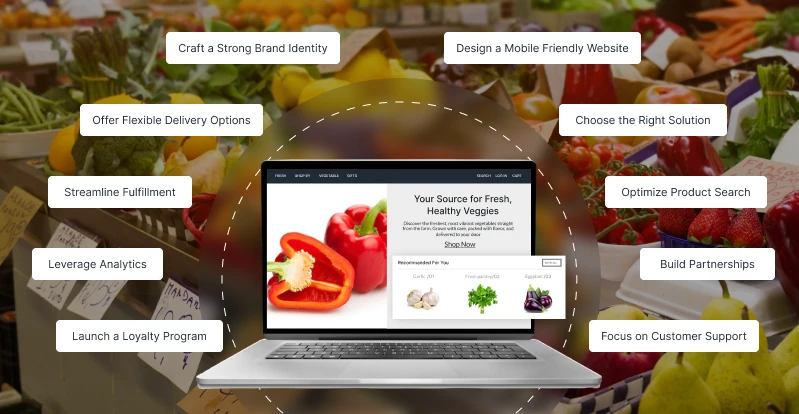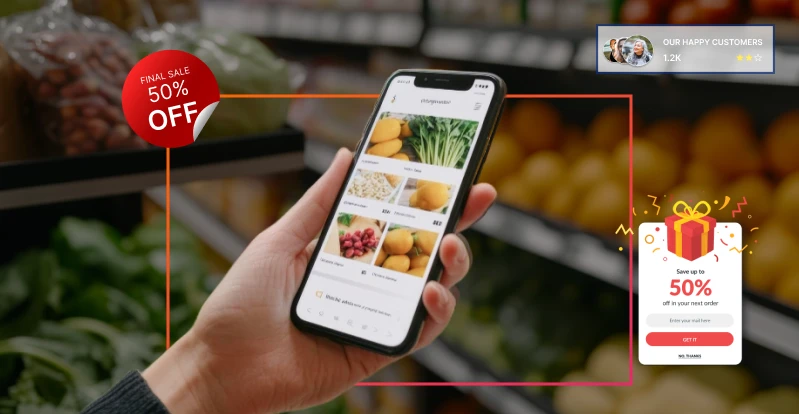Discover The Powerful Strategies to Build a Successful Grocery Store In Australia

Online shopping is growing in popularity, which is transforming the grocery sector. Nowadays, more and more customers prefer to buy things online. They are drawing more towards the convenience of getting everything at their doorstep.
This eventually encourages grocers to change their strategies for the industry as customer preferences and purchasing habits go towards online platforms.
According to a recent study, the Australian grocery market is projected to grow at a 9.55% CAGR, reaching $13.22 billion by 2029.
In the grocery industry, a range of companies are vying for customers’ attention by offering them greater convenience and better experiences, including innovative grocery startups and well-known supermarkets. Grocery stores are always coming up with new concepts to be significant players in the eCommerce sector.
This article highlights the need for grocery companies to embrace the growth in the online market by examining doable strategies for starting an online grocery business.
Why are Online Grocery Store Solutions Gaining Popularity?
Online grocery shopping is becoming increasingly popular due to a major shift in consumer preferences, convenience, and technology. Today’s consumers want easy, convenient shopping that saves them time and gives them access to a large selection.
Since most people have been adopting online food shopping out of necessity and will continue to do so since it provides the many advantages listed below:
Create a User-Friendly Website
The digital face of your grocery shop is your website; therefore, its design and performance are critical to attracting and retaining customers. A fully responsive, mobile-friendly site provides a seamless experience for on-the-go shoppers, and easy navigation with prominent categories, search bars, and filters allows visitors to simply locate what they need.
To keep customers engaged, optimise graphics and code for lightning-fast loading rates, which reduces the chance of cart abandonment due to delays. Additionally, secure payment gateways with a variety of alternatives and SSL encryption foster trust and assure safe transactions.
By concentrating on the following, you may develop a dependable, visually appealing, and user-friendly online store that will undoubtedly increase its appeal in this competitive field.
A Strong Inventory Management System
A key component of online shopping grocery brands’ success is effective inventory management. By preventing customers from viewing unavailable items, real-time inventory tracking lessens disappointment and improves the buying experience.
Inventory management software integration with your online store allows automatic stock updating and low inventory warnings so you can meet demand and preserve customer happiness.
Focus on Delivery and Fulfillment
Deliveries that are dependable and quick are essential to online grocery shopping. Various delivery choices, including scheduled deliveries, click-and-collect, and same-day service, should be offered to your clients. 72% of customers choose online grocery shopping for its convenience.
An effective delivery process can help save time and money by streamlining routes with AI-driven logistics solutions. Additionally, engage reputable local couriers or develop your own fleet for higher control over delivery quality and a seamless customer journey.

Tailor the Customer Experience
Providing a personalized touch to an online grocery store can significantly increase the consumer experience. Allow consumers to shop more intuitively and enjoyably by implementing AI-driven product recommendations based on individual browsing and purchasing histories.
These must offer unique shopping list features where customers can add their favorites to be reordered conveniently. Additional loyalty programs should also be available to reward repeated consumers using points or specific discounts on a purchase that build long-term relationships and stimulates continuous buying.
Investing in Digital Marketing
Promoting your eCommerce grocery business is critical for improving visibility and accelerating growth. Begin by optimising your website with targeted keywords, appealing meta descriptions, and high-quality content to help it rank better in search results.
Use social media marketing to create strong relationships with the target audience through interesting posts, offers, and customer testimonials published on Instagram and Facebook. Leverage email marketing by sending newsletters that contain special offers, personalized suggestions, and updates to create increased consumer engagement.
Finally, increase traffic with targeted sponsored ads on Google and social media, targeting specific demographics to maximise your store’s reach and influence.
Competitive Pricing and Promotions
Price-sensitive supermarket shoppers are always looking for good deals, and you may attract them with savvy pricing techniques. Offer discount bundles by grouping complementary items at discounted rates, resulting in savings and ease.
Use limited-time promotions to create urgency and encourage customers to buy right away. Establish free shipping thresholds so that customers can place larger orders without paying a thing for delivery. All of these moves benefit price-conscious consumers while also fostering client loyalty and increased sales.

Sustainability
Your eCommerce grocery store must adopt green practices since clients who care about the environment prefer businesses that put sustainability first. To package delivery in an eco-friendly way, use recyclable or biodegradable materials.
By using vendors and farmers, you may reduce your ecological footprint and promote community development. In addition, encourage zero-waste shopping by rewarding bulk purchases or providing reusable container alternatives. These sustainable efforts not only appeal to environmentally conscious customers, but they also boost your brand’s reputation and devotion to the earth.
Analytics for Improvement
Businesses can obtain significant insights into their success by using analytics software to track key performance measures such as sales, customer behaviour, and website traffic. This information enables the discovery of top-selling products and developing trends, allowing businesses to fine-tune their offerings.
How Grocery Stores Should React to the Rise of Online Marketplaces
The development of online retail has significantly altered what customers anticipate. In a world where change and improvement are anticipated, traditional grocery stores cannot stay the same. This is where. Here is how grocery stores can respond accordingly
Omnichannel Retailing
Customers can enjoy unmatched ease with a seamless hybrid approach that combines digital and physical interactions. Allowing customers to place online orders and pick them up in-store is one approach to closing the gap between online and in-store purchasing. Ising of appropriate mobile applications can enhance the experience by allowing for simple shopping and tracking of loyalty rewards.
A study reveals that 50% of grocery shoppers prefer an omnichannel shopping approach. Furthermore, combining physical stores with digital promotions can increase foot traffic, resulting in a unified shopping experience that meets customers where they are, both online and in-store.
Invest in Technology
The appropriate technology has the potential to transform operations and consumer experiences. Businesses that use artificial intelligence for demand forecasting may effectively predict client needs, assuring optimal stock levels. Automated checkout systems speed up the purchasing process while lowering labour costs.
Furthermore, adding chatbots gives fast assistance personalised recommendations and improves overall customer happiness. This technological mix not only improves productivity but also enhances the shopping experience, resulting in a fluid and responsive environment for both businesses and their customers.
Leverage Local Advantages
Local grocery stores give personalised service, and a community focus that online-only companies may struggle to match. To capitalise on these advantages, local retailers should promote their fresh, locally sourced items, providing customers with something different that larger chains cannot.
Additionally, offering unique products that are not available in big-box retailers could aid in brand differentiation. By supporting in-store activities or collaborating with other nearby companies, these stores may foster a sense of community and give their patrons a more meaningful shopping experience.
Retention of Customers
Keeping existing customers is typically less expensive than finding new ones, and there are a number of ways to encourage loyalty. Offering personalised reward schemes ensures that clients will feel valued and recognised for their ongoing patronage.
Regular feedback collection enables firms to improve their services and better fulfill client needs. Furthermore, delivering unique discounts to long-term clients not only expresses gratitude but also improves their connection to the business, creating long-term loyalty and satisfaction.
Partner with eCommerce Platforms
Partnerships with proven online platforms such as Instacart or Amazon Fresh enable traditional grocery retailers to enter the online market swiftly and efficiently. These platforms have a well-established consumer base, allowing companies to reach a large audience quickly.
They also offer comprehensive logistics and delivery solutions, easing the process of delivering online orders. With important insights about customer behaviour and preferences, these systems allow grocery retailers to adjust their products, resulting in a more personalised and smooth shopping experience.
Offer More Products
Grocery businesses can differentiate themselves from eCommerce giants by offering distinctive products that cater to specific client demands. This could include organic, vegan, or special items that are popular among health-conscious buyers.
Additionally, offering ready-to-eat meals or simple meal kits caters to busy customers seeking quick and easy solutions. Seasonal or holiday-themed products can entice customers by generating a unique offering that large-scale eCommerce platforms may be unable to match, all while improving the entire customer experience.
Conclusion
Businesses looking to expand and adjust to the changing needs of their clientele can benefit greatly from online grocery shopping. Developing an effective eCommerce grocery store may be a challenging but worthwhile undertaking if you include advanced technology, offer first-rate customer care, and put good marketing methods into practice.
Digital change is urgently needed for conventional brick-and-mortar grocery stores. These companies need to capitalise on their local advantages if they want to succeed.
Grocery companies may maintain their competitive edge, foster client loyalty, and experience long-term success in the online market by implementing these tactics. Working together with grocery specialists can also help ensure quality and remarkable business growth.




